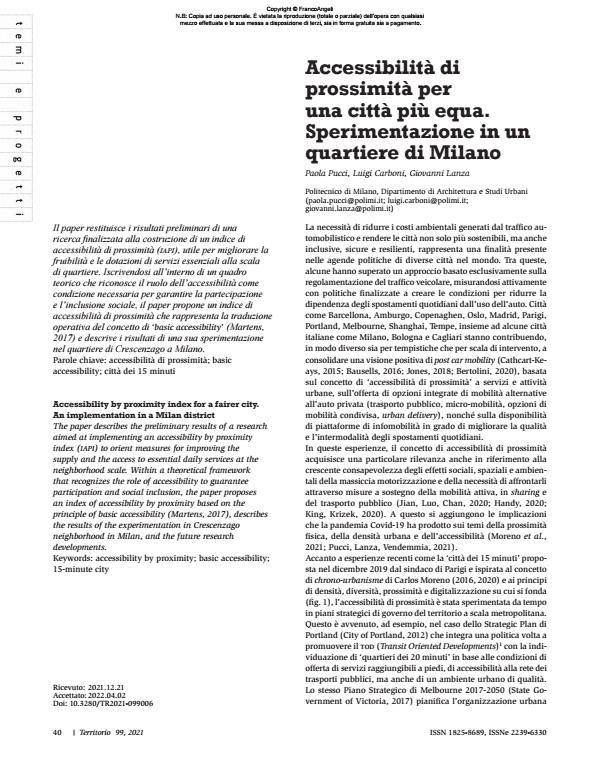Accessibility by proximity index for a fairer city. An implementation in a Milan district
Journal title TERRITORIO
Author/s Paola Pucci, Luigi Carboni, Giovanni Lanza
Publishing Year 2022 Issue 2021/99
Language Italian Pages 13 P. 40-52 File size 624 KB
DOI 10.3280/TR2021-099006
DOI is like a bar code for intellectual property: to have more infomation
click here
Below, you can see the article first page
If you want to buy this article in PDF format, you can do it, following the instructions to buy download credits

FrancoAngeli is member of Publishers International Linking Association, Inc (PILA), a not-for-profit association which run the CrossRef service enabling links to and from online scholarly content.
The paper describes the preliminary results of a research aimed at implementing an accessibility by proximity index (iapi) to orient measures for improving the supply and the access to essential daily services at the neighborhood scale. Within a theoretical framework that recognizes the role of accessibility to guarantee participation and social inclusion, the paper proposes an index of accessibility by proximity based on the principle of basic accessibility (Martens, 2017), describes the results of the experimentation in Crescenzago neighborhood in Milan, and the future research developments.
Keywords: accessibility by proximity; basic accessibility; 15-minute city
- Enabling Immobilities: Social and Spatial Implications for Urban Planning Giovanni Lanza, pp.9 (ISBN:978-3-031-80998-9)
- Computational Science and Its Applications – ICCSA 2023 Workshops Federica Stabile, Chiara Garau, Silvia Rossetti, Vincenza Torrisi, pp.209 (ISBN:978-3-031-37122-6)
- Computational Science and Its Applications – ICCSA 2023 Workshops Giovanna Acampa, Luca S. D’Acci, Fabrizio Finucci, pp.91 (ISBN:978-3-031-37128-8)
- Questioning Proximity - Opportunities and Challenges for Urban Planning and Mobility Policies Paola Pucci, Giovanni Lanza, pp.43 (ISBN:978-3-031-66070-2)
- Enabling Immobilities: Social and Spatial Implications for Urban Planning Giovanni Lanza, pp.63 (ISBN:978-3-031-80998-9)
- How do SUMPs Consider Factors Influencing Walkability and Cyclability? A Review of Literature and Planning Tools Silvia Rossetti, in European Transport/Trasporti Europei /2024 pp.1
DOI: 10.48295/ET.2024.97.9
Paola Pucci, Luigi Carboni, Giovanni Lanza, Accessibilità di prossimità per una città più equa. Sperimentazione in un quartiere di Milano in "TERRITORIO" 99/2021, pp 40-52, DOI: 10.3280/TR2021-099006